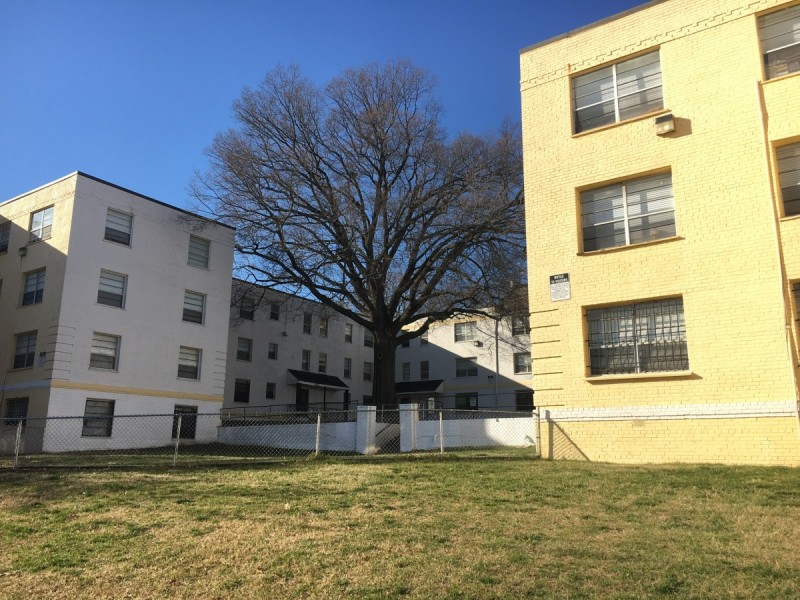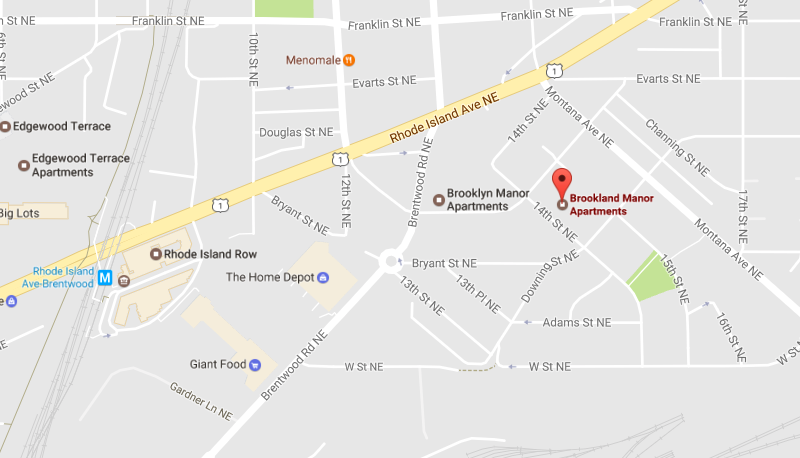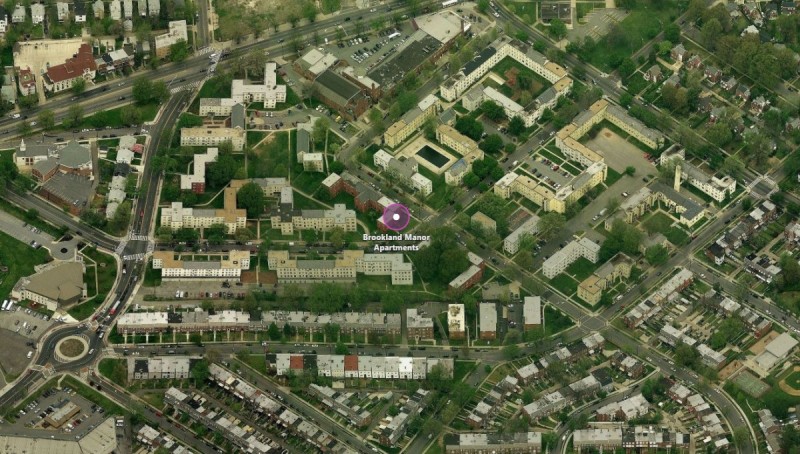Brookland Manor: What’s there now, what the owners want to build, and what that could mean for affordable housing

Brookland Manor today, viewed from Saratoga Avenue NE. Image by the author.
This post is part of an ongoing series about Brookland Manor, a controversial development project just east of the Rhode Island Metro station that epitomizes the complex dynamics building housing— especially affordable housing— in DC. Read the introduction to this series here.
Brookland Manor is a large apartment complex in Brentwood, a short walk from the Rhode Island Metro station, where most of the tenants receive some form of government housing subsidy. It’s also home to a case study on development and affordable housing across our region.
MidCity Financial Corporation, the owner of the property, is nearly finished paying off its federally-subsidized mortgage. Once it does, it plans to redevelop the site. How much of the existing affordable housing should MidCity replace?
DC law says the company doesn’t have to replace much. So while MidCity plans to do more than the legal minimum, tenants and housing advocates argue it’s not doing nearly enough for the people who currently live on the property, or other low-income families in DC. These conflicting arguments matter because MidCity is asking for exemptions to DC zoning law through a process that requires the company to give something back to the community.
There’s a lot of detail here, but if you’re at all interested in questions of how our region should grow and who benefits from change, I think you’ll want to take it in. The Brookland Manor case could be around for the better part of the next decade.
Brookland Manor is just east of the Rhode Island Avenue Metro station. Image by Google Maps.
For decades, a few different affordable housing programs have helped low-income families live at Brookland Manor
Brookland Manor is a 535-unit apartment complex built in the late 1930s in Brentwood that covers roughly 20 acres. It has one, two, three, four and five-bedroom apartments that are affordable to low-income families (a family of three with income below roughly $30,000 could live there). Larger affordable apartments have become increasingly hard to find in DC.
MidCity’s plans to redevelop Brookland Manor have sparked debate about the new project’s size, the number of affordable and multi-bedroom units, and the fate of current residents.
MidCity bought Brookland Manor in 1977 after the buildings had fallen into disrepair. The company signed a low-interest 40-year mortgage with the Department of Housing and Urban Development (HUD). In exchange, MidCity agreed to participate in HUD’s project-based section 8 program for the duration of the mortgage, which meant it reserved 373 of the apartments for low-income Washingtonians. Those residents pay a third of their income in rent while HUD pays the remainder to MidCity.
For decades, the remaining roughly 150 apartments not in the project-based section 8 program have been rented at market rates. They, too, were occupied by low-income tenants because the buildings are old and in a less expensive neighborhood, and therefore more affordable (these units were also subject to a version of rent control required under the federally-subsidized mortgage)
Today, almost all of the families in the non-section 8 units are low-income and most use housing choice vouchers from DC’s Housing Authority (DCHA) to subsidize their rent. They’re able to do that because the natural rents at Brookland Manor fall below DCHA’s “approved” maximum rent for the neighborhood.
As DC rents rise, it has become harder for voucher-holding families to find such apartments west of the Anacostia River. In effect, Brookland Manor is an uncommon location in a fast developing part of the city where these families can find apartments that work with their vouchers.
How the expiring HUD contract and a redevelopment could change the affordability situation
After MidCity pays off its mortgage to HUD this year, its affordability contract with HUD will expire. That means MidCity will be free to charge higher rent for those 373 apartments (subject to rent control). In the absence of the redevelopment, that might not change the affordability picture much: the apartments would likely continue to have low market rents, allowing housing voucher-holders and moderate-income families to continue living there.
But the buildings are almost 80 years old, and will need to be refurbished eventually. And if the property is redeveloped with newer apartments, the market rents will rise. The market rate units will also become exempt from rent control. Without action to preserve their affordability, both the 373 former-section-8 apartments and the remaining roughly 150 units would likely become too expensive for low-income families, including those with housing choice vouchers.
The complex consists of similar white rectangular buildings. Image by Bing.
Here’s what MidCity wants to build at Brookland Manor
Now that the section 8 HUD contracts (and their restrictions concerning affordable housing) are ending, MidCity plans to redevelop the complex. Subject to the demands of DC government and its investors, the company can choose to provide more, fewer, or the same number of affordable units as exist there now.
MidCity’s redevelopment plans have gone through several iterations. The plan that’s currently on the table would look something like this sketch of the original proposal, but shorter:
Image by MidCity.
Three years ago, the company began applying for a “Planned Unit Development” (PUD), which grants developers exceptions to zoning rules. PUDs allow developers to build more than the base zoning would otherwise allow (for example: taller or more dense projects). To get that “zoning relief,” they must provide “community benefits,” which, depending on the demands of neighbors and DC government, can range from bikeshare stations and flower beds to affordable housing.
MidCity’s PUD application for Brookland Manor asks for permission to build 20-25 feet taller than current zoning (C-2-A and R-5-A) allows. Partly in exchange for that added density, MidCity has offered the following with respect to affordable housing:
- To renew its section 8 HUD contract. Out of the 521 apartments that are currently affordable to low-income families, this would replace the current 373 deeply affordable HUD units with 373 new ones. (There are 535 total apartments, but MidCity uses nine as offices or to house staff while five units have been “offline for decades,” according to a spokesperson).
- To set aside 11 townhomes for low- and moderate-income families, making below 50% and 80% of area median income (AMI). That’s about $49,000 and $60,000 for a family of three, respectively.
MidCity’s initial redevelopment plan, which it put forward in 2014, rose to 90 feet above Rhode Island Avenue and had 2,235 units. The current, revised plan (which the zoning commission allowed to move forward in 2015) has a maximum height of 65 feet and contains 1,760 units, 20% fewer than in the initial plan. (Why that downsizing happened is the subject of my next post.)
If MidCity wanted to ditch the entire PUD process, build fewer total units, and keep fewer affordable units, it legally could. DC’s existing inclusionary zoning law only requires about 10 percent of the new dwellings be made affordable, often split 50/50 between those below 50% of AMI and those below 80% of AMI. MidCity could also sell the property to someone else for a boatload of money, since Brookland Manor is a 10 minute walk from Metro. Building taller, however, would be more profitable because it would mean more units to sell or rent.
On the other hand, MidCity could put 535 affordable apartments in the new place — the number tenants say effectively exist there now.
By keeping 373 apartments in HUD’s section 8 program and making 1,273 market rate, MidCity might say that it’s trying to save some affordable housing and make money at the same time. Company representatives have also said that they would work with existing residents to allow them to stay on site during construction, following what are known as “build-first” principles. To recap, here’s the breakdown:
- 1,760 total units
- 114 townhomes, of which 11 will be affordable to moderate and low-income families through inclusionary zoning. The remaining 103 will be market rate.
- 1,646 apartments, of which 373 will be deeply affordable, placed under a new section 8 HUD contract. The remaining 1,273 will be market rate.
See here for more detail on MidCity’s plan.
Tenants and housing advocates aren’t thrilled with this plan. They want to see 535 affordable apartments in the redevelopment, and they think that’s a modest ask for reasons I’ll cover in coming posts. Many also have concerns about the details of the resident relocation plan, and they say MidCity has engaged in a “mass displacement campaign” in the lead up to construction.
This PUD process is ongoing
MidCity’s proposed redevelopment covers several blocks. After the zoning commission approved their overall plan for the entire site in 2015, the company now has to ask for approval on the details of each stage of redevelopment. There could be up to four of these “second-stage” PUDs, stretching out almost a decade into the future.
The details of MidCity’s revised plan are before the Zoning Commission right now. After meeting this Monday, the commissioners decided to postpone a decision on whether or not to allow the redevelopment to proceed, pending more information from MidCity. The commissioners plan to announce a decision on May 22nd.
Those are the basics. There’s a whole lot more to this story.
In the next series of posts, I’ll get into why this redevelopment has become so controversial, including the conflicts over the treatment of tenants, and the sizes and amounts of affordable housing. Before we go there, here’s the cast of characters and issues at Brookland Manor, which I’ll cover in the next three posts:
-
The Brookland Manor/Brentwood Village Resident Association is the complex’s tenants group. Their members like the idea of redeveloping the aging buildings. But they’re concerned that MidCity isn’t going to build enough replacement affordable homes, and that they won’t be able to return once the project is completed. They’re also concerned that there won’t be enough larger, family-sized apartments for multigenerational Brookland Manor households. Will Merrifield, a lawyer with the Washington Legal Clinic for the Homeless, is representing them before the Zoning Commission. ONE DC, a nonprofit, is helping organize the tenants association, along with volunteers around DC concerned about displacement.
-
MidCity is the developer that owns the property. Its leadership says it has already met nearly all of the tenants’ concerns, and says that they are developing a model “mixed-income community,” pointing to the company’s history in affordable housing construction.
-
Edgewood Property Management, a sister company to MidCity founded by the same man, oversees Brookland Manor along with a private security company. Last year, Edgewood’s practices vis-à-vis tenants were the subject of a Washington Post investigation.
-
Covington and Burling is the law firm that, along with the Washington Lawyers’ Committee, is bringing a class-action suit against MidCity for allegedly violating DC law and the Fair Housing Act, by discriminating against families (a protected class under that law).
-
The Zoning Commission is a five-member quasi-judicial body charged with enforcing and amending DC’s zoning laws. Through the PUD process, the Commission has become the public arena in which some of these battles over affordability, tenant protections, and displacement are being fought.
-
The Office of Planning, which “guides development” in DC by shaping land-use policy, helps decide if MidCity’s plans are “consistent” with DC’s Comprehensive Plan.
-
A handful of neighbors that opposed the proposed height and density of the redevelopment.
